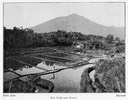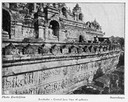
Front ebook cover of Black Sun, Red Moon: A Novel of WWII Java. This design shows a gendaito ('modern sword’) and shodo calligraphy for giri (‘duty’ or ‘obligation') over a red moon and/or rising sun. The blade was forged by the Japanese swordsmith Uchifusa around 1936. (See other great photos of this sword by Geoff Smith in my Gallery.) The sword mounts are fairly typical WWII shin gunto (‘new army sword’) type. (This image replaced the first cover design in August 2018. No reproduction permission required for press comment or review purposes. Reviewers and bloggers may reproduce this image provided no alterations are made, no advertising links are present (except to this title at booksellers) and no questionable or offensive language or image appears on the same page. WW2, second world war, Far East War, WWII novel, Japan

Front book cover of Merdeka Rising: Part Two of Black Sun, Red Moon: A Novel of Java. The design incorporates a mid-to-late 19th century Javan keris (kris) dagger over the national flag of Indonesia, which was first flown ‘officially’ at the declaration of Indonesian independence at the close of WWII in August 1945. The revolutionary war in Indonesia started soon afterwards. The keris blade is naga (‘moving') with several luq (curves). No reproduction permission required for press comment or review purposes. Reviewers and bloggers may reproduce this image provided no alterations are made, no advertising links are present (except to this title at booksellers) and no questionable or offensive language/image/video appears on the same page.

Traditional, hand-forged, 'modern' Japanese sword (現代刀,gendaito) by the swordsmith Ujifusa (c. 1935). Mounts are of the New Army Sword (新軍刀, shin gunto) type with company officer-grade tassel in blue and orange. In Black Sun Red Moon and Merdeka Rising, Lt Ota uses such a weapon. Photo Copyright Geoff Smith. (Sword: Courtesy of VP Collection.)

Imperial Japanese Army infantry officer (a 1st Lt) in a family photograph (c.1937), perhaps after a New Year shrine visit (or the graduation of the seated cadet). The officer's sword is in traditional mounts, and not shin gunto (新軍刀) variants, which might suggest a family blade. Photograph: Rory Marron Collection. 軍刀 日本陸軍 katana

Javanese wayang kulit (shadow puppet) play, 'Audience with Yudistra' (Mengahadap Yudistra) Copyright © Jim Henry. (This photo is also used on the back cover of the Black Sun, Red Moon paperback edition.)

Map (detail): Semarang, Ambarawa, Oengaran, Salatiga. (16th Imperial Japanese Army map of Java [ジァワ] produced in 1943.) In Merdeka Rising the relief convoy races against time from Semarang to Ambarawa. Rory Marron Collection.

Antique Javan keris/kris with luq/luk (waves/bends) representing the naga, a mythical serpent. In Black Sun, Red Moon: A Novel of Java, a similar weapon is made by the empu Taruna for Lamban, the young Indonesian nationalist. Rory Marron Collection. Copyright © Rory Marron ジァワ

1920s Royal Packet Navigation Company/Koninklijke Paketvaart Maatshcappij (KPM) advertisement for its weekly Singapore-to-Java service on the Melchior Trueb steamer. (From Come to Java, 1923.) (As featured in Black Sun, Red Moon: A Novel of Java.)

Hand-forged, 'modern'(c. 1935) Japanese sword or gendaito (現代刀) by the smith Ujifusa. The blade is in shin-gunto (新軍刀, New Army Sword) mounts with company officer-grade (blue and brown) tassel. In Black Sun, Red Moon: A Novel of Java, Lt Ota carries a similar sword to this one, while his friend, Lt Nagumo carries an older, feudal-era, katana blade, a ‘true' nihonto (日本刀). Photo: Copyright Geoff Smith. (Sword: Courtesy of VP Collection) iado, iaijutsu, toyama ryu

Early ‘DIY’ cover-image design for Black Sun, Red Moon: A Novel of Java. Vintage wayang kulit (shadow puppet) of 'Samba' backlit on to WWII Japanese yosegaki ( 寄書き 'group effort' or good-luck) flag. Puppet and flag, Rory Marron Collection. Photo: © Rory Marron
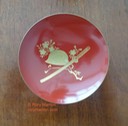
Imperial Japanese Army 'China War' commemorative military sake cup (軍隊盃 gun sakazuke) with sword (軍刀, gunto), helmet (with star) and sakura (cherry blossom) design. (Red and gold lacquer, d.10cm) RM Collection.

Two young Imperial Japanese Army (旧日本軍) soldiers (a junior officer on the left, with sash) of the 50th Infantry Regiment during hanami (the cherry blossom-viewing) season in Matsumoto City, Nagano prefecture. (Late-1930s). Photo: Rory Marron Collection.

Yosegaki (寄書き'Good Luck' flag), Java keris (kris) dagger, Gurkha kukri knife and Japanese army sword (軍刀 gunto). (Another early cover design for Black Sun, Red Moon.) © Rory Marron

Si Jageor ('Mr Sturdy'!) cannon, Batavia (Jakarta) as it was displayed in the 1930s. As featured in the novel Merdeka Rising.

Ex-PETA (Japanese-established and trained) Indonesian militiamen (TKR/TNI) with Japanese kit and weapons during the early part of the Indonesian revolution (Press photo, Java, c.1946.) Tentara

Full-cover design for the paperback edition of Black Sun, Red Moon: A Novel of Java. Developed by John Amy (info[at]ebookdesigner.co.uk) from RM's brief. No reproduction permission required for press comment or review purposes. Reviewers and bloggers may reproduce this image provided no alterations are made, no advertising links are present (except to this title at booksellers) and no questionable/offensive language/image/video appears on the same page. RM.

Full-cover design for the paperback edition of Merdeka Rising. Developed by John Amy from RM's original design. No reproduction required for press comment or review purposes. Reviewers and bloggers may reproduce this image provided no alterations are made, no advertising links are present (except to this title at booksellers) and no questionable/offensive language or image appears on the same page. RM.

'Indonesia-Japan Friendship' commemorative monumental stone presented to the people of Japan by (then) President Sukarno during a state visit to Tokyo in the 1960s. Photo © Rory Marron.
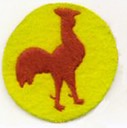
23rd Indian Division 'The Fighting Cock' shoulder patch worn in Java by British Commonwealth forces. (As mentioned in the cock-fighting scene in Merdeka Rising.)

Indonesian Declaration of Independence, 17 August 1945. President Sukarno (at the microphone) and Dr Hatta to his left. Source: Wikipedia.
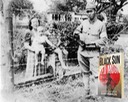
'Behind the barbed wire': A rare photograph of an internee woman and her children with a Japanese soldier in Southeast Asia, c. 1943. [Soldier later KIA, other annotation withheld.] Photo: Rory Marron Collection. Black Sun, Red Moon: A Novel of Java recounts (in part) a 'captor-captive’ love story.

Isuzu Type-94 6-wheel truck. (In Black Sun, Red Moon Kate and Juliette and some of the other women in the camp are transported to the brothel in one of these vehicles.) Source: (confirmation pending)

Original South-East Asia Command (SEAC) shoulder patch worn in Burma and Java by Major Dean Miekle, an officer with the Gurkha rifles. RM Collection. Photo: © Rory Marron.

10 roepiah [rupiah] note, isued by the Imperial Japanese Government (Dai Nippon Teikoku) during the occupation of the Netherlands East Indies (later Indonesia), 1942-1945. Photo: © Rory Marron Collection

Tien/Ten 10 gulden [guilder] note issued by the Japanese Military Government during the occupation of the Netherlands East Indies (Indonesia), 1942-45. Photo: © Rory Marron Collection

Imperial Japanese Army currency (gunpyo), 10-yen note, issued in occupied Southeast Asia 1942-45. Photo: © Rory Marron Collection
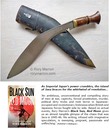
Gurkha kukri knife, WWII-issue with twin-rivetted rosewood handle (length: pommel to tip, 20.5"/52cm, weight: 725g/1lb 8oz). This is the type of weapon carried by 'Rai' and his Gurkha comrades in the novels Black Sun, Red Moon and Merdeka Rising. Rory Marron Collection. Photo: © Rory Marron

First front cover: Black Sun, Red Moon. The design incorporates a wayang kulit (shadow puppet) figure over a rising sun. The design was changed to the current cover in August 2018. No reproduction permission required for press comment or review purposes. Reviewers and bloggers may reproduce this image provided no alterations are made (size/crop excepted), no advertising links are present (except to this title at online booksellers) and no questionable or offensive language appears on the same page.

First front cover of Merdeka Rising. The design incorporates a keris (kris) dagger, a wayang kulit (shadow puppet) of 'Samba'. No reproduction permission required for press comment or review purposes. Reviewers and bloggers may reproduce this image provided no ratio alterations are made, no advertising links are present (except to this title at booksellers) and no questionable or offensive language/image/video appears on the same page.

Japanese army officers celebration prior to departure for the front, c. 1940. Photo: Rory Marron Collection. (Annotation on the back of this photo reads, in part: 'farewell dinner for the captain [centre, moustache] who has been posted to fight in China’.)ino-Japanese war.
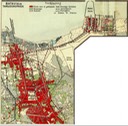
Batavia [Jakarta], 1935 (Source: Schoolatlas der Geheele Aarde by P.R. Bos and J.F. Niermeyer. (J.B. Wolters, Groningen, Den Haag; Batavia: 1935)

Semarang, 1935 (Source: Schoolatlas der Geheele Aarde by P.R. Bos and J.F. Niermeyer. (J.B. Wolters, Groningen, Den Haag; Batavia: 1935). Tjandi, the location of the internee camp in Black Sun, Red Moon, is marked at the bottom (centre).

Surabaya (Soerabaja), 1935 (Source: Schoolatlas der Geheele Aarde by P.R. Bos and J.F. Niermeyer. (J.B. Wolters, Groningen, Den Haag; Batavia: 1935)

Japanese troops detrucking. Soldier’s Guide to the Japanese Army (Military Intelligence Service, War Department, Washington, DC. November 1944.)

Wartime kendo (剣術) tournament for Imperial Japanese Navy (大日本帝國海軍) personnel. Location possibly Bougainville island (Papua New Guinea). (This is the type of dojo imagined in Black Sun, Red Moon: A Novel of Java, though the kendoka are wearing hakama [wide, pleated trousers]). Photo: AWM (PD).

Kendo (剣術) bout between Japanese soldiers. Soldier’s Guide to the Japanese Army (Military Intelligence Service, War Department, Washington, DC. November, 1944.) A very similar scene is described in Black Sun, Red Moon: A Novel of Java by Rory Marron. (PD)

Children performing military drills in Java, c. 1944. (Japanese propaganda photograph.) A similar 'parade' is described in Black Sun, Red Moon.

Come to Java: An example of the pre-war travel guide used by the war-reporter, 'Meg Graham’ (a thinly disguised Martha Gellhorn) in the novels Black Sun, Red Moon and Merdeka Rising.

'Java the Wonderland', preface to Come to Java guide book, 1923, by the 'Official Tourist Bureau'. The guide is featured in both of the novels Black Sun, Red Moon and Merdeka Rising.
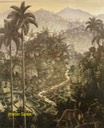
Enchanting Indonesian (Bali?) landscape by German artist Walter Spies (d. 1942) showing sawah (rice paddy terraces) and lontar palms.
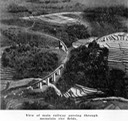
Main railway line and terraced rice fields (sawah) in 1930s Java (from Java: Handbook for Servicemen, 1945)

Drawing of fighting cocks and their handlers by Walter Spies. Spies, a German artist, was deported from Bali by the Japanese in 1942 after their capture of the Dutch East Indies. His (Japanese) ship was bombed and Spies drowned (along with many others). (This image inspired the cock-fighting scene in Merdeka Rising.)

Cover of Java: Handbook for Servicemen, 1945. (The guide reveals the somewhat 'optimistic' Allied assumptions over expected co-operation in the re-imposition of Dutch control in Java. See next photo.)
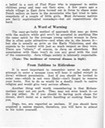
Page 24 from Java: Handbook for Servicemen produced (in Australia?) in early 1945 under the auspices of the US War Department for units serving in the South-West Pacific Area (SWPA) and SEAC, offering advice on sexual behaviour to servicemen used to 'modern white girls' in approaching 'the average young native woman' and warnings about 'others' (prostitutes) in Java. 'She is often quite attractive—and when she is, she knows it—but she is usually as prim as the Early Victorians…' It ends, 'Java village society is intensely respectable. (Note: The incidence of veneral disease is high)'.

The Melchior Treub berthed at Singapore, c. 1935. Courtesy, Tropmuseum of the Royal Tropical Institute (KIT). In Black Sun, Red Moon war reporter 'Meg Graham' travels from Singapore to Batavia/Jakarta aboard this ferry on which she meets the mysterious Dr Jarisha…

HNMS Tijgerhaai ("Tigershark"), previously HMS Tarn (Pennant 336) until 1944 when she was assigned to the Royal Dutch Navy. This submarine features in Black Sun, Red Moon: A Novel of Java and Merdeka Rising.
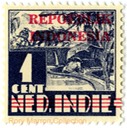
Japanese Occupation and Revolutionary period Repoeblick Indoneisa/Netherlands Indies (Ned. Indie) 1 cent stamp overfranked 'Repoeblick Indonesia'. (Java SG#J1 MNH). Rory Marron Collection.

Commemorative military sake bottle or flask (tokkuri, 徳利) with design of a map of Asia in outline relief and the Japanese empire depicted in an orange glaze (c. 1932). In Black Sun, Red Moon Major Kudo and General Yamagami drink from such flasks. Rory Marron Collection (h. 13cm). Photograph © Rory Marron.

Type-30 bayonet (銃剣 juken or tanken) adopted in 1897 and used by Japanese forces until 1945 with the Model 38, 44 and 99 Arisaka rifles. Length (total): 18.5" (51cm); weight: 1lb 1oz (480g). Factory stamps: Matsushita Metals (松下金属) Kokura (小倉) Supervision. Photo: © Rory Marron Collection. tanken

Japanese Arisaka (有坂銃) Type-99 7.7mm rifle as used in China, Burma, Netherlands East Indies, French Indo-China and the Pacific campaigns. This is a mid-war example and shows the rough manufacture typical of this period. Japanese units described in Black Sun, Red Moon and Merdeka Rising carry this weapon. (Photo courtesy of Lawrance Ordnance Pty Ltd, Australia).

Japanese Arisaka rifle (Arisaka-ju, 有坂銃) Type-99 7.7mm rifle. This example has a defaced (filed or ground-off) kikukamonsho (菊花紋章) or Imperial chrysanthemum ('mum') crest or stamp, often found on rifles surrendered post-15 August 1945. The kanji read ’99 model’. (Photo courtesy Lawrance Ordnance Pty Ltd, Australia.)

Imperial Japanese soldier taking aim with an Arisaka rifle (Type 99, later model?). Source: Soldier’s Guide to the Japanese Army (MIS, War Department, Washington, DC., 1944.)

Japanese Arisaka rifle 2.5x sniper scope (shooter’s view). In the novels Black Sun, Red Moon and Merdeka Rising, Kudo Butai marksman, Pte Harada, uses such a scope when the Japanese come under British command in an attempt to save Dutch internees from revolutionary mobs. (Photo courtesy of japanmilitaryfirearmsparts.com.)

British Lee Enfield No. 4, Mk.1 .303 rifle. Issued from 1941 onwards. This example dates from 1943 and is typical of those used in Burma, Malaya and the Dutch East Indies (now Indonesia). The weapon features in Black Sun, Red Moon and Merdeka Rising. (Photo courtesy of Lawrance Ordnance Pty Ltd, Australia.)

Surrendered Japanese soldiers (JSP) demonstrate bayonet fighting jukenjutsu/jukendo (銃剣道) for Australian armed forces personnel on Labuan Island, North West Borneo in November 1945. (This type of combat features in Black Sun, Red Moon/Merdeka Rising in the scene between Ota and the young nationalist, Lamban. The Imperial Japanese armed forces adapted many traditional sojutsu [槍術] or spear-fighting techniques into bayonet drill. Photo: AWM. PD. (Still enhanced by RM.)

Jukendo/jukenjutsu (銃剣術) or bayonet fighting demonstration by surrendered Japanese for Australian troops at Timbali Surrender Camp, Labuan Island. Filmed (by Reginald M. Barrett) on 27 November 1945. AWM ID No. F07408. Kendo armour (bogu) is worn with extra padding on the left shoulder and chest but only one glove. (In Merdeka Rising, Ota uses his jukendo and kenjutsu skills against the nationalist Lamban, who wields a Javanese klewang [sword] and keris dagger.) This is great footage, click to view! (Australian War Memorial website is here.)

Buddha statue, Borobudur [Borobudor] temple, Central Java. (From the travel guide, Come to Java, 1923.) This statue is described in the 'sunrise scene' in Merdeka Rising.

One of the swords surrendered by General Yamamoto Moichiro (the model for 'General Yamagami' in Black Sun, Red Moon and Merdeka Rising) in Jakarta/Batavia in 1945 to British forces. (Sold on eBay UK in 2008, now in a private collection.) Photo © Ron Warner.

Imperial chrysanthemum crest (kikukamonsho [菊花紋章]) on the pommel of a sword surrendered by General Yamamoto Moichiro to a Royal Navy officer (aboard HMS Cumberland) off Jakarta (Batavia) in late 1945. (Private collection.) Photo © Ron Warner. mon

Yasukuni Shrine (Haiden or Main Hall and Chumon torii or Middle Shrine Gate), Kudanshita, Tokyo. (Photograph © Rory Marron) controversial visits by political leaders such as the Prime Minister and the Japanese cabinet.
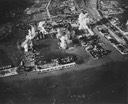
Aerial photo of bombing raid on Surabaya, Eastern Java, April 1944. (Photo: US Navy, National Archives, Washington, DC.) The mouth of the Kali Mas canalised river is visbile at the right-hand side. The ill-fated 49 Indian Infantry Brigade disembarked on the North side of the inner harbour in October 1945 . They would lose 427 men in three days in ferocious, last-man-stands with Indonesian nationalists in what was the 'first' Battle of Surabaya, making it the first post-Second World War defeat for British forces (as portrayed in Merdeka Rising, part two of Black Sun Red Moon: A Novel of Java). Britain retaliated on 10 November with air strikes and a naval bombardment of the city prior to a landing by 5 Indian Division, which took the city after three weeks of fighting in a 'second' Battle of Surabaya. Surabayans celebrate the defence of their city on 10 November as Hari Pahlawan or Heroes' Day. Gun-camera (16m) footage of this (or a similar) raid can be seen on YouTube (see '1944 Air Raid on Soerabaja, Java'. (All official US Navy WWII photographs and film footage is in the Public Domain.)

Imperial Japanese Army troops (c. early 1942) on Bougainville Island in jungle camouflage. Japanese propaganda photo. The annotation also states that there are five soldiers in this photograph. (This original photo has been retouched to remove many dust spots, scratches and processing stains, so please credit 'Rory Marron Collection' if reused elsewhere.)

Borobudur Temple (Java) terrace, c. 1920 (J. Olbertz) b/w postcard. This image has been incorporated into the back cover design of Merdeka Rising. (The temple is the romantic location for the 'sunrise scene' featuring Meg, an American war reporter, and Mac, a British soldier in the Seaforth Highlanders.
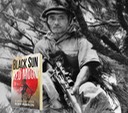
Imperial Japanese Army sniper in the Pacific or China theater equipped with an Arisaka rifle with 2.5x scope. In the novels Black Sun, Red Moon and Merdeka Rising by Rory Marron, Kudo Butai sniper Pte Harada uses such a weapon, first to target British Gurkhas and then, under British command, against Javanese nationalists to save Dutch internees during the Indonesian revolution. This photo is obviously a staged, IJA promotional ‘shot’ as, normally, snipers tend to be somewhat camera shy... Photo: IJA/PD


